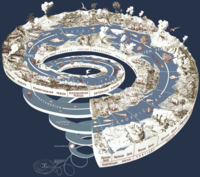
Photo from wikipedia
This paper presents new zircon U–Pb geochronological, Hf isotopic and whole‐rock geochemical data for the granitic plutons in the Xing'an Massif, Northeast China, to constrain the Late Mesozoic tectonic evolution… Click to show full abstract
This paper presents new zircon U–Pb geochronological, Hf isotopic and whole‐rock geochemical data for the granitic plutons in the Xing'an Massif, Northeast China, to constrain the Late Mesozoic tectonic evolution of the Mongol‐Okhotsk Ocean and the Paleo‐Pacific Ocean. The zircon U–Pb ages indicate that the granitoids emplaced during the Late Jurassic–Early Cretaceous. The granodiorites show an adakitic affinity with high Sr/Y ratios and low Yb (< 1.30 μg/g) contents. The monzogranites exhibit high SiO2, low MgO contents, enrichment in LILEs (Rb, K, and Th), and depletion in HSFEs (Ta, Nb, Zr, P, and Ti). Petrological and geochemical features of these monzogranites suggest that they are highly fractionated I‐type granitoids. In addition, the zircon εHf(t) values and two‐stage model ages (TDM2) are in the range of +2.6 to +8.1 and 669–1011 Ma, respectively, indicating that primary magma was generated by partial melting of juvenile lower‐crustal materials, and there was a significant crustal growth in the Phanerozoic in the Northeast China. Combined with the coeval granitoids widely exposed in the Xing'an Massif, we conclude that the Late Jurassic magma in Northeast China was generated in an extensional setting related to the closure of the Mongol‐Okhotsk Ocean, but the Early Cretaceous magma was related to the subduction of the Paleo‐Pacific Plate.
Journal Title: Island Arc
Year Published: 2020
Link to full text (if available)
Share on Social Media: Sign Up to like & get
recommendations!